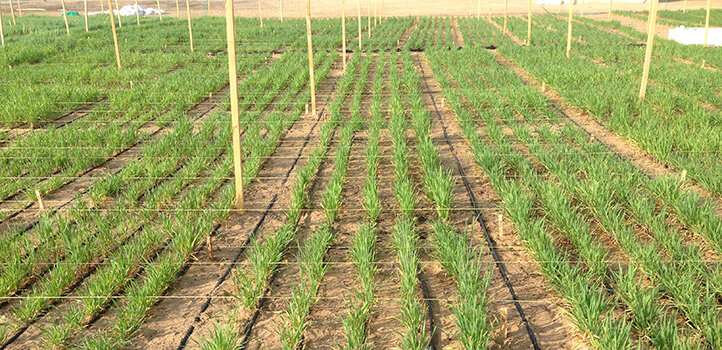Barley crops in a field trial. Credit: 2019 KAUST
Plant scientists are striving to cultivate crops that can cope with saline soils in the hope that this may help feed the world's growing population, particularly in the face of climate change. Now, KAUST researchers have applied a newly developed robust statistical technique to examine how different barley plant traits affect yields grown in saline and nonsaline conditions.
"The problem with traditional regression analyses is that they focus on finding the average, or mean, of a given distribution," says Gaurav Agarwal, who worked on the project under the guidance of his supervisor Ying Sun and in collaboration with plant scientists Stephanie Saade and Mark Tester.
"In plant science, this incomplete picture can be frustrating because we're often more interested in details at the extreme ends of the distribution and what these data can tell us about optimizing crops," says Agarwal.
The two research groups turned to new advanced quantile regression techniques to analyze the traits that influence salt tolerance and yield in barley plants. The team modeled the saline and nonsaline conditions jointly, dividing up the data into different "quantiles" to build up a more detailed picture of the entire distribution. In this way, they could focus their analyses on those plant groups that displayed higher yields and greater tolerance and then examine the main influencing factors.
The team's results provide interesting insights into barley's responses and could inform future crop decisions, particularly in arid parts of the world.
Two key traits help gain high yield under saline conditions. Firstly, the plants' flowering time should not occur too late in the growing season. Late flowering may mean that the plant is affected by increased heat as the season progresses, reducing its ability to produce seeds.
"A more surprising result was that the salinity tolerance of plants increased linearly as the ear number per plant increased," says Agarwal. "However, tolerance then faltered when a plant grew more than three ears. A possible explanation is that the plant can cope with salt stress while producing seeds, but only up to a point, after which generating seeds comes at the expense of salinity tolerance."
"We are keen to expand on these initial results," adds Sun. "Our insights may also help further understanding of mechanisms of salt tolerance in barley and other crops."
More information: Gaurav Agarwal et al, Quantile function modeling with application to salinity tolerance analysis of plant data, BMC Plant Biology (2019). DOI: 10.1186/s12870-019-2039-9
Journal information: BMC Plant Biology























